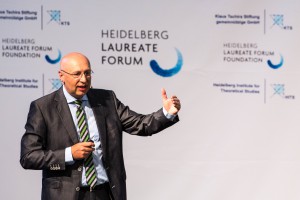Role model for mathematicians? Stefan Hell’s career
BLOG: Heidelberg Laureate Forum

Could this have happened in mathematics? The story of Stefan Hell’s career is, in a good way, a scientific fairytale: the young researcher with an unusual, guiding idea – an idea that, if translated into practice, would topple a basic law of optics that had been accepted as gospel for hundreds of years. Years of struggle in exile in a cold and dark country (in Finland), then the sudden breakthrough, and finally the scientific equivalent of marrying the beautiful princess, 0,5 kingdoms included: a prestigious position, a Nobel prize. With the new way of doing microscopy that Hell developed, he could beat the diffraction barrier for light microscopes, resolve structures smaller than the magical boundary of 200 nanometers, and make the interactions within accessible to observations. In Hell’s own words: to open up a new world.

Could this have happened in mathematics? Compared with mathematical theorems, physical laws are like icebergs: Underneath the textbook statement of the law – what, in the modern type of text book, you find in colored boxes, ready for bachelorial memorization – are numerous assumptions; in a good text book, you will find all of them in the pages leading up to the box version of the law; in a bad text book, you might find at least some of them. Change the situation so that one of the assumption doesn’t apply, and you might have found a situation in which the law doesn’t apply.
In Hell’s case, in the practical version of the law limiting optical resolution for light microscopes, what produces the smeared out, resolution-limited image is the hodgepodge of light produced by all the different molecules in the sample. Hell’s method of STED microscopy (Stimulated Emission Depletion) uses a special configuration of lasers to “turn off” almost all of the molecules, leaving only a few of them to radiate. The process of turning the molecules off, stimulated emission, makes use of some of the basic quantum properties of matter – a fitting ingredient for undermining an optical law that had been formulated long before the advent of quantum theory. Scanning the sample in this way, the resolution limit can be beaten. Not because the elementary properties of light have changed, but because one of the underlying, unspoken assumptions (that all molecules are busily radiating practically all the time) had been changed.
Could this have happened in mathematics? In a way, it is happening all the time. If all goes to plan, a well-stated theorem will have all its assumptions on display, ready for inspection. Choosing an assumption and seeing whether it can be weakened while retaining either the old or a new version of the proof, leading to a more general form of the theorem. In that respect, Hell’s finding had an almost mathematical air about it. But of course, where a method is common, there is nothing special about it. And where all assumptions lie open, it is much more natural to test them than for the iceberg divers of physics. But there are some cases where assumptions indeed went unquestioned for a long time, and their relaxation opened up new worlds. Probably the best-known case is Euclid’s fifth postulate of geometry in the plane, which is equivalent to the statement (by John Playfair) that for a given line and a point not on that line, there is exactly one additional line drawn through the given point that never intersects the first line. It took more than 2000 years for Gauss, Bolyai, Lobachevsky and others to find other, non-Euclidean geometries, and to show that ordinary school geometry is just one part of a much richer structure. (Incidentally, when this structure was generalized by Riemann, it became the basis of Albert Einstein’s general theory of relativity.)
Can you think of other interesting examples from mathematics? If yes, please describe them in the comments section! And if you want to see for yourself: Here is Stefan Hell’s 2015 HLF lecture on video.


One fundamental limitation of the mathematical logic that is the basis of our computers, is its static or contemporaneous nature (contemporaneous meaning: occurring or existing at the same time). A new world opens up with the advent of non contemporaneous logic, introduced in “Natural Logic of Space and Time.”